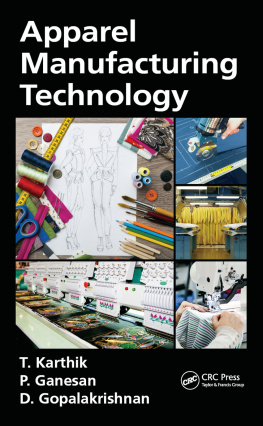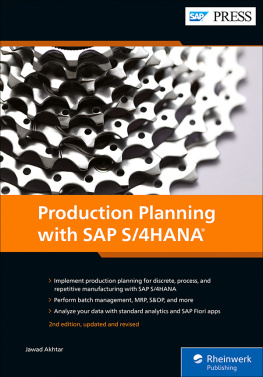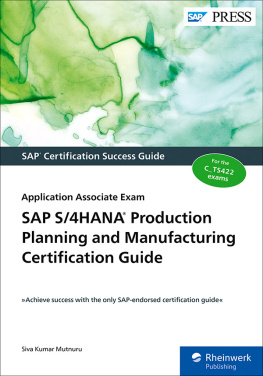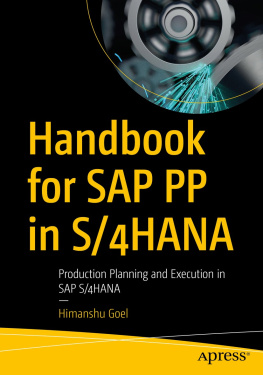Contents
Page List
Guide

Apparel Manufacturing Technology
Apparel Manufacturing Technology
T. Karthik
P. Ganesan
D. Gopalakrishnan

CRC Press
Taylor & Francis Group
6000 Broken Sound Parkway NW, Suite 300
Boca Raton, FL 33487-2742
2017 by Taylor & Francis Group, LLC
CRC Press is an imprint of Taylor & Francis Group, an Informa business
No claim to original U.S. Government works
Printed on acid-free paper
Version Date: 20160317
International Standard Book Number-13: 978-1-4987-6375-2 (Hardback)
This book contains information obtained from authentic and highly regarded sources. Reasonable efforts have been made to publish reliable data and information, but the author and publisher cannot assume responsibility for the validity of all materials or the consequences of their use. The authors and publishers have attempted to trace the copyright holders of all material reproduced in this publication and apologize to copyright holders if permission to publish in this form has not been obtained. If any copyright material has not been acknowledged please write and let us know so we may rectify in any future reprint.
Except as permitted under U.S. Copyright Law, no part of this book may be reprinted, reproduced, transmitted, or utilized in any form by any electronic, mechanical, or other means, now known or hereafter invented, including photocopying, microfilming, and recording, or in any information storage or retrieval system, without written permission from the publishers.
For permission to photocopy or use material electronically from this work, please access www.copyright.com (http://www.copyright.com/) or contact the Copyright Clearance Center, Inc. (CCC), 222 Rosewood Drive, Danvers, MA 01923, 978-750-8400. CCC is a not-for-profit organization that provides licenses and registration for a variety of users. For organizations that have been granted a photocopy license by the CCC, a separate system of payment has been arranged.
Trademark Notice: Product or corporate names may be trademarks or registered trademarks, and are used only for identification and explanation without intent to infringe.
Library of Congress Cataloging-in-Publication Data
Names: Karthik, T., author. | Ganesan, P. (Industrial engineering professor), author. | Gopalakrishnan, D., author.
Title: Apparel manufacturing technology / T. Karthik, P. Ganesan, D. Gopalakrishnan.
Description: Boca Raton : Taylor & Francis, a CRC title, part of the Taylor & Francis imprint, a member of the Taylor & Francis Group, the academic division of T&F Informa, plc, [2016] | Includes bibliographical references.
Identifiers: LCCN 2016004249 | ISBN 9781498763752 (hardcover : acid-free paper)
Subjects: LCSH: Dressmaking. | Clothing factories. | Clothing trade. | Manufacturing processes.
Classification: LCC TT497 .K38 2016 | DDC 687--dc23
LC record available at http://lccn.loc.gov/2016004249
Visit the Taylor & Francis Web site at
http://www.taylorandfrancis.com
and the CRC Press Web site at
http://www.crcpress.com
Contents
As known to all of us, clothing is a basic necessity for humankind. It serves as a true reflection of peoples economic and social status. The improvement in the standard of living of people is showcased by the variety of clothing people wear. The lifestyle of the people is depicted based on the type of apparel worn by them. Apparel manufacturing industries have gained greater popularity in recent years owing to the popularity of ready-to-wear garments. Bulk production has reduced the cost of apparel and quality is maintained. The apparel industry is very diverse in nature and along with textile industries, it forms a complex combination of performing heterogeneous functions of transforming fibre into yarn and then to fabric. The diverse nature can be attributed to the variety of products manufactured and the requirements of people related to apparel has increased manifold times. Clothing for functional purposes has been replaced by aesthetic and fashion clothing. Because of this inevitable growth, the textile and clothing sectors are gaining more relevance with respect to economic and social terms as it leads to more income, jobs in the short term and provides economic and social development for countries in the longer run. As this industry is becoming more fashion oriented with customisable clothing, the need and potential for value-added products is increasing day by day. This need has given rise to research and development in this area to stay afloat in competition. Another notable point is that the apparel industry is a labour-intensive one and hence it provides huge job opportunities at all levels of manufacturing and managing including scope for entry level unskilled labourers. This is a huge economic boost for both developing and developed nations to reduce their unemployment index levels. In this sector, technological advancements have led to further developments in the manufacturing and designing areas. The best part is that these technologies can be implemented by all countries including poorer ones as the cost required is comparatively lesser than other sectors and hence the feasibility of using new technologies is high.
The abolition of a quota system, liberalisation and globalisation have led to greater competition and changes in the world economic outlook. The success of the apparel industry has become dependent on the cost competency aspect. In the last decade or so, it has been noticed that there is an emergence of a postindustrial production system that is able to achieve the goal of mass customised, low-volume production. Supply chain efficiency has become very critical in todays scenario and hence more advanced and sophisticated technologies like JIT (just in time) delivery, vendor managed inventory and third-party logistics are being used to improve the manufacturing processes and also result in more cost efficiency. The clothing sector was initially art-based and later it evolved into technology-based after undergoing several changes. The technological advancements in the apparel industry include the use of computer-aided designing and pattern making, fit analysis software, 3D scanning technology, automation and robotics, integration of wearable technology, biomimetics, artificial intelligence and advanced material transport systems. The requirement now is that the industry should embrace all these technologies with open arms by being creative enough to design innovative products, introducing new materials and processes and having flexibility in manufacturing by following proper supply chain practices.
This book will help readers satisfy the requirements stated in the above paragraph as it provides greater knowledge in explaining the basic concepts of selection of raw material, classification of garments, various stages in manufacturing of garments and performance tools for measuring the same. Further, the book delves into the apparel engineering aspects such as production planning and control, layout of plants and costing aspects of garments. The following 20 chapters provide a critical overview of clothing manufacturing and engineering aspects in the apparel industry.
provides insight into the various aspects related to the classification and selection of the sewing thread and needle for construction of garments and their influence on sewing performance.










